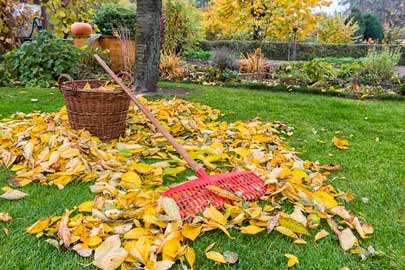In fall, as we survey our landscape after a long, hot summer, we might be reminded of the song by folksinger and songwriter Pete Seeger, Turn, Turn, Turn:
"To everything, turn, turn, turn.
There is a season, turn, turn, turn.
And a time to every purpose under heaven.
A time to be born, a time to die.
A time to plant, a time to reap…"
The song reference reminds us all that there is a time for every purpose—indeed. And in fall, when we might think our lawns and gardens are slowly slipping into a winter’s sleep, in fact, this is the ideal time to reap, sow, feed and prepare the earth to experience a miraculous revival next spring.
It’s almost counter-intuitive—to think when leaves fall and fruits and flowers are stunned by morning frost, that this could be the time to prepare the soil, plant trees, shrubs, bulbs and perennials and feed your turfgrass. But it is true!
 While you rake the leaves, the tines of a stiff rake will naturally de-thatch the grass.
While you rake the leaves, the tines of a stiff rake will naturally de-thatch the grass.
iStock/Thinkstock
Rather than mourning the brown spots in your lawn or ignoring the leaves and uneven edges of your flower beds, take action! The crisp and cool fall air is more enjoyable for outdoor activities anyway. Reseeding smaller patches of grass or laying sod on larger areas to extend the greening season, and overseeding where needed are ideally done in fall. Bluegrass, for example, actually prefers cooler temperatures to develop. Mowing the newly seeded areas will further encourage a fall growth spurt.
Soil maintenance is consistently beneficial for landscape health and beauty, season after season. While you rake the leaves, the tines of a stiff rake will naturally de-thatch the grass, and if you find the soil underneath has compacted under foot-traffic or the effects of weather, de-compacting by aeration will make sure the soil can absorb and store maximum nutrients over the winter months. In early fall, starting in September, apply GreenView Fairway Formula Fall Fertilizer to your grass with a drop or broadcast spreader. The GreenView formula contains 59% slow release nitrogen, which fertilizes up to 12 weeks. Slow release nitrogen provides your lawn with controlled, steady nutrition over a longer period of time, resulting in thicker, healthier grass. Feeding your lawn in fall will repair summer damage from heat, insects, and drought. You’ll mow less because there is no excess growth. What will grow is a full root system for that healthy, deep green lawn.
 Dead-heading flowers let’s you enjoy the last of the color and keeps fall gardens looking tidy.
Dead-heading flowers let’s you enjoy the last of the color and keeps fall gardens looking tidy.
iStock/Thinkstock
But don’t stop with the soil and feeding. Throughout the summer, your lawn has overgrown the edges of your flower beds, your perennials have turned to dead-heads, and the boundaries and borders you so carefully laid out in April may be lost. Take the time to trim and edge your beds and borders now, and in spring, you’ll enjoy a beautiful display of nature, trained to fill the spaces you’ve prepared. Clean up the flower beds by cutting back those early season blooming perennials, such as daylily, hosta, coneflower, black-eyed Susan and iris, for a neater landscape and to save you more time next spring. But don’t touch the mums—they will grow more heartily if left alone. It’s much easier to do this now than fight back in spring when wet weather and rapid growth ensues.
 Fall is a great time to find shrubs on sale and plant them so they can establish before winter sets in.
Fall is a great time to find shrubs on sale and plant them so they can establish before winter sets in.
iStock/Thinkstock
Your grounds-cleaning efforts should extend to an inspection of water features, bird baths, feeders and nesting boxes, cleaning thoroughly, repairing and preparing for winter. Fall is the best time for planting most trees, shrubs, evergreens, grasses and perennials, as long as you do it early enough for them to establish roots. Inspect your landscape for any open spaces that you may want to fill with interesting or early blooming specimens. This is the time to consider large or small landscape renovation projects, new flowerbeds or seating areas, or new landscaping designed to attract birds. Need a splash of color early next spring? Fall is the time to plant an amazing array of spring bulbs like tulips and daffodils to make a fabulous statement in spring.
Think you should only mulch in spring? Surprisingly, fall is an ideal time for this weed preventative as well. Mulching helps your plantings retain moisture and it inhibits weeds. But more importantly for fall, mulch forms a protective barrier against the ravages of cold weather and killing frost, and it’s an especially good insulation for your perennial garden.